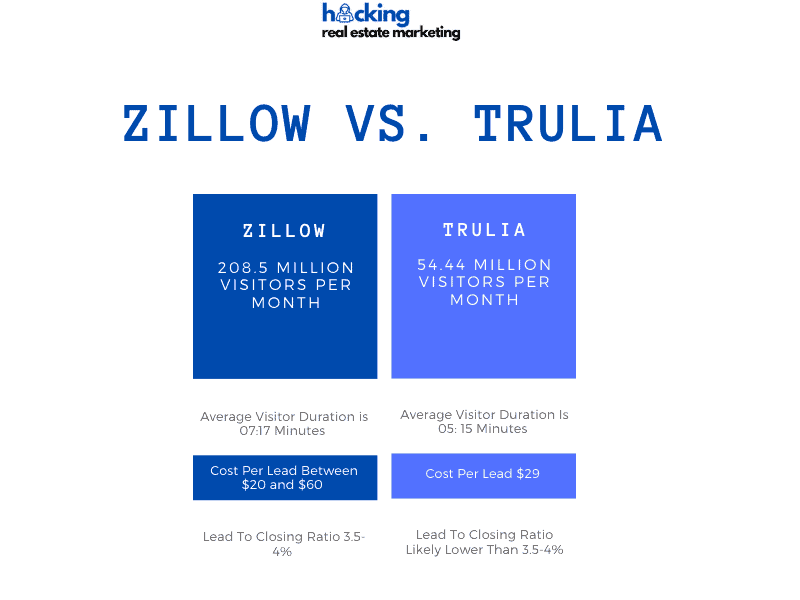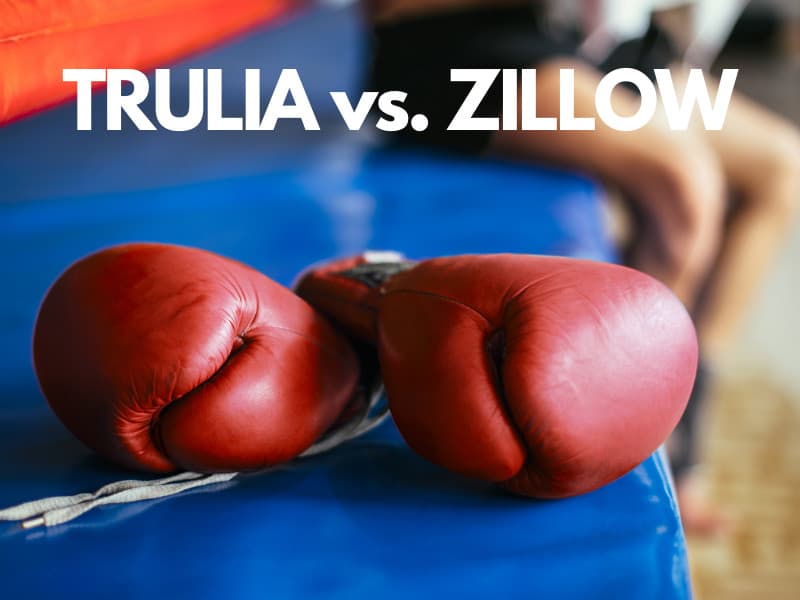During the research for my last article, I started to wonder about two well-known real estate listing platforms and which one is better; Zillow or Trulia.
I can break it into two sentences: Zillow is slightly better for marketing purposes, but you have to consider that both have merged into one platform.
The end user, who uses them preferably for research purposes, may still find differences in terms of interface design and different types of property data illustration.
Let’s dig deeper and find out how both make money now.
How Do Zillow and Trulia Make Money
1) Zillow
Zillow is what is called a typical two-sided online platform based on A2A (agency-to-agency), B2C (agency-to-customer), and P2P (peer-to-peer).
It features an extensive listing for home renting, buying, leasing, inquiring, and renovating.
About 157 million average monthly users visit the website per month, according to their annual report from 2018.
On the one hand, individual sellers can list their homes, and on the other hand, homebuyers can search for properties for free.
The primary income comes from selling advertising to real estate pros, such as agencies, brokers, and realtors. It also helps property managers or landlords to find tenants.
It is called the Premier Agent and Broker program.
Advertising prices depend on market demand by location and competition. As a realtor or broker, you can pay them per lead or 1000 impressions (per 1000 ad views, also called CPM).
If you are a property manager looking for tenants, it’s slightly different. Here you pay them per click, lease, or lead.
Additionally, they sell advertising space (display advertising) to real estate-related businesses, such as mortgage brokers, lenders, and more.
The cost per 1000 impressions CPM on Zillow could be over $100 (source).
And if you pay per lead, the costs are between $20 and $60.
2) Trulia
Trulia was bought by Zillow in mid-February 2015, so much for being different.
It is like Zillow, a two-sided platform that generates the most revenue from subscription products and advertising.
Since Trulia was acquired by Zillow, it manages advertising through the Premier Agents features of Zillow.
On Trulia’s website, it reads as follows:
‘Advertisers previously using Trulia Local Ads and Trulia Mobile Ads will now be converted to Zillow Premier Agents and appear across both sites and mobile apps; agents can no longer purchase Trulia Local Ads or Trulia Mobile Ads.’
How Are Zillow Features Different From Trulia Features
Suppose you are the end user using Zillow and Trulia for property research purposes. In that case, you will find differences in functionality, design, and property data representations.
You can research properties for sale and rent and get a nice map view displayed where you can zoom in.
After you enter a specific area where you are looking for properties, the property map on Zillow is displayed on the left, and the particular homes are on the right.
On Trulia, this is vice versa (map on the right and further property information on the left).
If you search a particular listing and then drill down, you will realize that the information is nearly identical.
Why is that?
The property data seems to come from the same Multiple Listing Service (MLS) or other sources.
Zestimate is Zillow’s unique feature to calculate a home’s value. It is a controversial tool, as you can read in this article.
Not long ago, Trulia also had a unique tool called heat maps.
It was a map view of a particular area where you could view different areas colored green, orange, or red.
Red indicates where most property transactions at higher home value prices took place.
For some undisclosed reason, they got rid of this feature.
It’s unfortunate since I know it was a helpful tool, especially for real estate investors, to identify areas of high demand where properties would move fast.
The home search sites use the same listings database, so from a consumer standpoint, the main difference is how they are presented graphically.
Zillow vs. Trulia Statistics
Let’s look at Zillow and Trulia from a marketing perspective and compare some statistics.
You will get a better basis on which we might find out which one is better, at least for real estate marketing.
1) Zillow
- There are 110 million properties listed on Zillow (source)
- The website receives 208,500,000 visitors per month and has an average visit duration of 07:17 minutes (source)
- Per month 420 million homes are viewed.
- Costs per lead are between $20 and $60.
- No direct information regarding the lead-to-closing ratio could be found.
2) Trulia
- According to Trulia’s main website, more than one million properties are listed. Since both are merged, we can assume it probably has the same amount of properties listed as Zillow.
- Trulia receives 54.44 million monthly visitors and has an average visit duration of 05:15 minutes. (source)
- No information was available regarding how many homes are viewed per month.
- Costs per lead are $29
- No direct information regarding the lead-to-closing ratio could be found.
Here I have an illustration for you so you have this comparison at a glance:

Conclusion
So, which one is better? Zillow or Trulia?
Suppose you want to use the platforms as a real estate professional for marketing purposes. I will say that Zillow is a bit better in that case.
Why?
Because the lead-to-closing rate is likely better than for Trulia.
Additionally, it gets more monthly traffic and has a longer visitor duration.
What if you only use the platforms to find a property to rent or buy?
In that case, it is a thing of personal preference which platform you might have used already, are more used to, and how you prefer property data displayed.
On both platforms, the property information itself is the same. The only difference is the way that it is presented.
This article has been reviewed by our editorial team. It has been approved for publication in accordance with our editorial policy.
- Performance Risks of “Marketing ROI Black Boxes” for Real Estate and other Industries - October 15, 2024
- What You Don’t Measure in Real Estate Marketing… - October 1, 2024
- What a Worn-Out Flight Attendant Has to Do with Your Real Estate Lead Gen ROI - September 17, 2024

